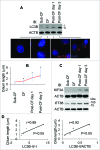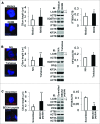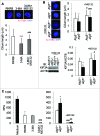Reciprocal regulation of cilia and autophagy via the MTOR and proteasome pathways
- PMID: 25906314
- PMCID: PMC4502771
- DOI: 10.1080/15548627.2015.1023983
Reciprocal regulation of cilia and autophagy via the MTOR and proteasome pathways
Abstract
Primary cilium is an organelle that plays significant roles in a number of cellular functions ranging from cell mechanosensation, proliferation, and differentiation to apoptosis. Autophagy is an evolutionarily conserved cellular function in biology and indispensable for cellular homeostasis. Both cilia and autophagy have been linked to different types of genetic and acquired human diseases. Their interaction has been suggested very recently, but the underlying mechanisms are still not fully understood. We examined autophagy in cells with suppressed cilia and measured cilium length in autophagy-activated or -suppressed cells. It was found that autophagy was repressed in cells with short cilia. Further investigation showed that MTOR activation was enhanced in cilia-suppressed cells and the MTOR inhibitor rapamycin could largely reverse autophagy suppression. In human kidney proximal tubular cells (HK2), autophagy induction was associated with cilium elongation. Conversely, autophagy inhibition by 3-methyladenine (3-MA) and chloroquine (CQ) as well as bafilomycin A1 (Baf) led to short cilia. Cilia were also shorter in cultured atg5-knockout (KO) cells and in atg7-KO kidney proximal tubular cells in mice. MG132, an inhibitor of the proteasome, could significantly restore cilium length in atg5-KO cells, being concomitant with the proteasome activity. Together, the results suggest that cilia and autophagy regulate reciprocally through the MTOR signaling pathway and ubiquitin-proteasome system.
Keywords: 3-MA, 3-methyladenine; 70kDa, polypeptide 1; ANKS6, ankyrin repeat and sterile α motif domain containing 6; ATG/atg, autophagy-related; Ac-TUBA, acetylated-tubulin α; Baf, bafilomycin A1; CF, confluence; CQ, chloroquine; DAPI, 4′-6-diamidino-2-phenylindole; FBS, fetal bovine serum; HK2, human kidney proximal tubular cells; IFT, intraflagellar transport; KAP3, kinesin family-associated protein 3; KD, knockdown; KIF3A/3B, kinesin family member 3A/3B; KO, knockout; LTA, lotus tetragonolobus agglutinin; MAP1LC3B/LC3B, microtubule-associated protein 1 light chain 3 β; MEF, mouse embryonic fibroblast; MTOR; MTOR, mechanistic target of rapamycin; OFD1, oral-ficial-digital syndrome 1; PBS, phosphate-buffered saline; PKD, polycystic kidney disease; RKRB, Krebs-Henseleit saline containing 25 mM NaHCO3; RPS6KB1, ribosomal protein S6 kinase; Rapa, rapamycin; SD, standard deviation; autophagy; cilia; polycystic kidney disease; proteasome.
Figures







Similar articles
-
The GST-BHMT assay reveals a distinct mechanism underlying proteasome inhibition-induced macroautophagy in mammalian cells.Autophagy. 2015;11(5):812-32. doi: 10.1080/15548627.2015.1034402. Autophagy. 2015. PMID: 25984893 Free PMC article.
-
ARG2 impairs endothelial autophagy through regulation of MTOR and PRKAA/AMPK signaling in advanced atherosclerosis.Autophagy. 2014;10(12):2223-38. doi: 10.4161/15548627.2014.981789. Autophagy. 2014. PMID: 25484082 Free PMC article.
-
The GID ubiquitin ligase complex is a regulator of AMPK activity and organismal lifespan.Autophagy. 2020 Sep;16(9):1618-1634. doi: 10.1080/15548627.2019.1695399. Epub 2019 Dec 3. Autophagy. 2020. PMID: 31795790 Free PMC article.
-
Interplay between primary cilia, ubiquitin-proteasome system and autophagy.Biochimie. 2019 Nov;166:286-292. doi: 10.1016/j.biochi.2019.06.009. Epub 2019 Jun 15. Biochimie. 2019. PMID: 31212039 Review.
-
The Role of Primary Cilia in the Crosstalk between the Ubiquitin⁻Proteasome System and Autophagy.Cells. 2019 Mar 14;8(3):241. doi: 10.3390/cells8030241. Cells. 2019. PMID: 30875746 Free PMC article. Review.
Cited by
-
Primary cilia-associated signalling in squamous cell carcinoma of head and neck region.Front Oncol. 2024 Aug 21;14:1413255. doi: 10.3389/fonc.2024.1413255. eCollection 2024. Front Oncol. 2024. PMID: 39234399 Free PMC article. Review.
-
Crosstalk of Hedgehog and mTORC1 Pathways.Cells. 2020 Oct 18;9(10):2316. doi: 10.3390/cells9102316. Cells. 2020. PMID: 33081032 Free PMC article. Review.
-
Primary cilium and its role in tumorigenesis.Zhejiang Da Xue Xue Bao Yi Xue Ban. 2021 Apr 25;50(2):245-260. doi: 10.3724/zdxbyxb-2021-0048. Zhejiang Da Xue Xue Bao Yi Xue Ban. 2021. PMID: 34137221 Free PMC article. English.
-
1,25-Dihydroxyvitamin D3 inhibits the proliferation of rat mesangial cells induced by high glucose via DDIT4.Oncotarget. 2017 Dec 9;9(1):418-427. doi: 10.18632/oncotarget.23063. eCollection 2018 Jan 2. Oncotarget. 2017. PMID: 29416624 Free PMC article.
-
ANGPTL8 accelerates liver fibrosis mediated by HFD-induced inflammatory activity via LILRB2/ERK signaling pathways.J Adv Res. 2023 May;47:41-56. doi: 10.1016/j.jare.2022.08.006. Epub 2022 Aug 27. J Adv Res. 2023. PMID: 36031141 Free PMC article.
References
-
- Graser S, Stierhof YD, Lavoie SB, Gassner OS, Lamla S, Le Clech M, Nigg EA. Cep164, a novel centriole appendage protein required for primary cilium formation. J Cell Biol 2007; 179:321–30; PMID:17954613; http://dx.doi.org/10.1083/jcb.200707181 - DOI - PMC - PubMed
-
- Cole DG, Diener DR, Himelblau AL, Beech PL, Fuster JC, Rosenbaum JL. Chlamydomonas kinesin-II-dependent intraflagellar transport (IFT): IFT particles contain proteins required for ciliary assembly in Caenorhabditis elegans sensory neurons. J Cell Biol 1998; 141:993–1008; PMID:9585417; http://dx.doi.org/10.1083/jcb.141.4.993 - DOI - PMC - PubMed
-
- Pan J, Wang Q, Snell WJ. Cilium-generated signaling and cilia-related disorders. Lab Invest 2005; 85:452–63; PMID:15723088; http://dx.doi.org/10.1038/labinvest.3700253 - DOI - PubMed
-
- Follit JA, Xu F, Keady BT, Pazour GJ. Characterization of mouse IFT complex B. Cell Motil Cytoskeleton 2009; 66:457–68; PMID:19253336; http://dx.doi.org/10.1002/cm.20346 - DOI - PMC - PubMed
-
- Ishikawa H, Marshall WF. Ciliogenesis: building the cell's antenna. Nat Rev Mol Cell Biol 2011; 12:222–34; PMID:21427764; http://dx.doi.org/10.1038/nrm3085 - DOI - PubMed
Publication types
MeSH terms
Substances
Grants and funding
LinkOut - more resources
Full Text Sources
Other Literature Sources
Molecular Biology Databases
Research Materials
Miscellaneous
